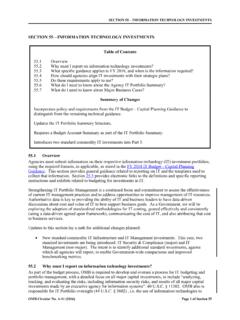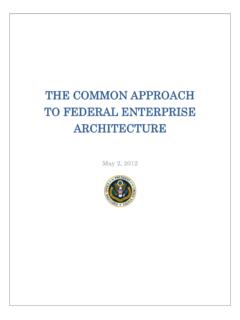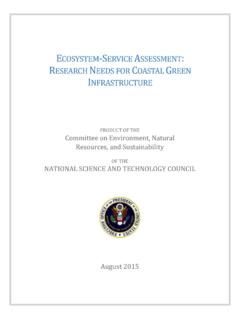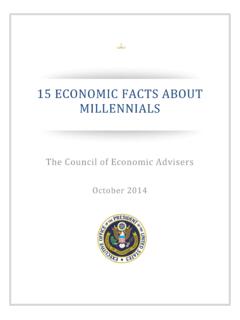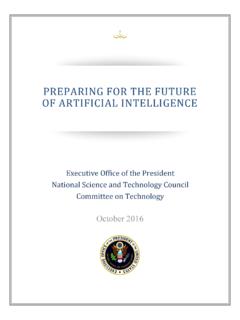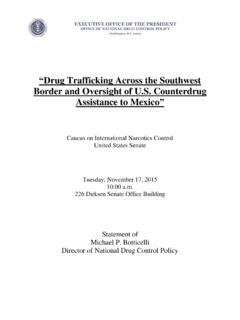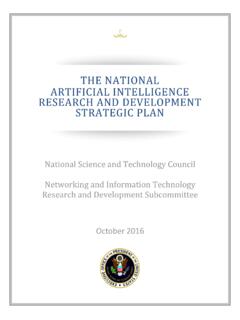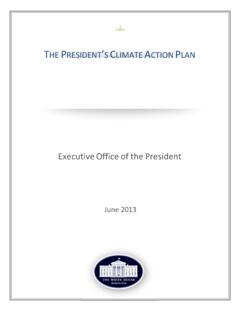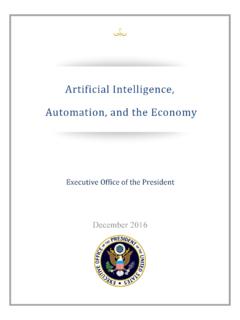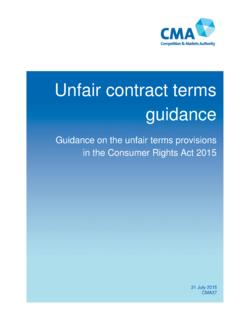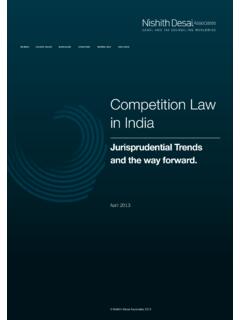Transcription of BENEFITS OF COMPETITION AND INDICATORS OF MARKET …
1 CO U N C I L O F EC O N O M I C AD V I S E R S IS S U E BR I E F UP D A T E D MAY 2 0 1 6 BENEFITS OF COMPETITION AND INDICATORS OF MARKET POWER Introduction This issue brief describes the ways in which COMPETITION between firms can benefit consumers, workers, entrepreneurs, small businesses and the economy more generally, and also describes how these BENEFITS can be lost when COMPETITION is impaired by firms actions or government policies. Several INDICATORS suggest that COMPETITION may be decreasing in many economic sectors, including the decades-long decline in new business formation and increases in industry-specific measures of concentration. Recent data also show that returns may have risen for the most profitable firms. To the extent that profit rates exceed firms cost of capital which may be suggested by the rising spread on the return to invested capital relative to Treasury bonds they may reflect economic rents, which are returns to the factors of production in excess of what would be necessary to keep them in operation.
2 Such rents may divert resources from consumers, distort investment and employment decisions, and encourage firms to engage in wasteful rent-seeking activities. The causes underlying a possible decrease in COMPETITION and corresponding increase in MARKET power are not clear, but candidate explanations include efficiencies associated with scale, increases in merger and acquisition activity, firms crowding out existing or potential competitors either deliberately or through innovation, and regulatory barriers to entry such as occupational licensing that have reduced the entry of new firms into a variety of markets. Government action can help reverse this trend. Antitrust authorities, namely the Department of Justice (DOJ) and the Federal Trade Commission (FTC), are charged with enforcing antitrust laws, challenging anticompetitive mergers, anticompetitive exclusionary conduct, and collusion by competitors.
3 Their enforcement actions can block consolidation that reduces COMPETITION in a MARKET , 1 While in theory these BENEFITS can accrue even when there are only a few firms or a single firm in the marketplace, provided that the monopolist faces a credible threat of entry by other firms (Spence 1977, sanction anticompetitive behavior, and help define the contours of antitrust law through court decisions. These measures not only have immediate effects on the behavior that is challenged but also may help deter anticompetitive abuses in the future. Promoting COMPETITION extends beyond enforcement of antitrust laws, it is also about a range of other pro-competitive policies. Several departments and agencies are actively using their authority to advance pro- COMPETITION and pro-consumer policies and regulations.)
4 For example, in several cases the Federal Aviation Administration (FAA) of the Department of Transportation (DOT) has sought to provide competitive airline carriers with greater access to take-off and landing slots at capacity constrained slot-controlled airports. The Federal Communications Commission (FCC), in its most recent design of a spectrum auction, established a MARKET -based spectrum reserve designed to ensure against excessive concentration in holdings of low-band spectrum. Other recent examples include government actions on cell phone unlocking, net neutrality, standards-essential patents, and defense acquisition and procurement. This brief argues that consumers and workers would benefit from additional policy actions by the government to promote COMPETITION within a variety of industries.
5 In addition, more work is needed to understand how policies that promote COMPETITION should be applied in the digital economy and other technologically dynamic sectors. BENEFITS of COMPETITION and Potential Harms from MARKET Power A long line of economic literature argues that COMPETITION among firms BENEFITS consumers via lower prices (for an overview, see Kovacic and Shapiro (2000)).1 Dixit 1980), the BENEFITS are more certain when there is vigorous COMPETITION among existing competitors. Tirole (1988) and Cabral (2000) provide useful overviews of the 2 COMPETITION can benefit consumers in other ways as well: COMPETITION may lead to greater product variety, higher product quality, and greater innovation, which drives productivity growth and helps lift living standards (Hotelling 1929; Aghion et al.
6 2005; Shapiro 2012).2 When there is little or no COMPETITION , consumers are made worse off if a firm uses its MARKET power to raise prices, lower quality for consumers, or block entry by entrepreneurs. A firm with MARKET power recognizes that if it reduces price to gain more customers, it loses revenue on the existing customers it already has. Thus, it may set a higher price and provide a lower quantity of its product than would maximize societal welfare. COMPETITION pushes firms to reduce price below this level, both to gain share from rivals, and in recognition that higher prices can be profitably undercut by competitors who are similarly trying to increase their sales. Alternatively, monopolists may choose not to upgrade quality or variety, which would also leave customers worse off than if the MARKET had competitors.
7 And monopolists may be less rigorous in pursuing efficient cost reductions, for as Sir John Hicks (1935) famously wrote, the best of all monopoly profits is a quiet life. COMPETITION between firms may also help workers. In the same way that two firms might compete against one another and lower prices to entice consumers to purchase a product, firms competing to hire from a specialized labor MARKET may raise wages to attract and retain workers. In addition, small businesses and entrepreneurs can benefit, for example, when upstream firms compete against each other for the opportunity to supply a product to a downstream small business or entrepreneur. If an entrepreneur sells its products to downstream firms rather than to end-users, it would benefit from there being a greater number of downstream firms to which it can sell products the greater the number of downstream firms, the better the ability to negotiate a good price for the products it sells.
8 Thus, whether the business model of an entrepreneur is business-to-business or business-to-consumer, COMPETITION among upstream firms and among downstream firms helps the entrepreneur grow his or theoretical conditions, assumptions, and extensions needed for these BENEFITS to accrue. 2 The link between COMPETITION , innovation and productivity growth is covered in greater detail in her business by creating and capturing value in the marketplace (Brandenburger and Stuart 1996). A firm that has MARKET power when purchasing inputs or hiring workers may be able to exploit its MARKET power, at least in the short-run. Monopsony power in the labor MARKET may lead a firm to restrict employment, reducing wages below what they would be in a competitive MARKET . In the classic example of isolated company towns in the late 19th and early 20th centuries, workers only had one option to which to sell their labor and hence could be exploited by this company, at least in the short run.
9 Boal (1995) finds some evidence of monopsony power in the short run on the part of coal mining firms that owned company towns in the early 1900s. But over the longer run, it appears that workers move to find better paying jobs if wages are too low. This dynamic highlights how the mobility of assets be they human, capital, or even digital may help to mitigate against MARKET power. Firms can move from exercising their MARKET power to the point where they are abusing it. Standard Oil at the turn of the previous century helped establish the impact and importance of antitrust laws. Before the implications of the Sherman Antitrust Act were clarified in early court decisions, Standard Oil had engaged in a variety of predatory tactics to weaken competitors (exclusionary conduct), purchased most of its direct rivals (horizontal integration) as well as a substantial portion of firms involved in other aspects of the oil industry (vertical integration), eventually gaining control over nearly 90 percent of oil production.
10 Standard Oil used its size to obtain better terms on transportation and other ancillary transactions than its smaller competitors could command. These deals in turn made it easier for Standard Oil to undercut smaller rivals, softening them for purchase or forcing them out of business, reducing capacity in the industry. In 1911, the Supreme Court found for the Department of Justice, and ordered that Standard Oil Company be dissolved on the grounds that it violated the Sherman Antitrust Act s prohibition on trusts and other business activities that restrained trade and commerce. Chapter 5 of the 2016 Economic Report of the President; available: 3 More recently, in United States v. Microsoft Corporation, a case originally brought in 1998 by DOJ and twenty State Attorneys General, the United States Court of Appeals for the Circuit found that Microsoft had abused its monopoly power, upholding the United States District Court for the District of Columbia s original findings of fact (even though it overturned the District Court s ultimate verdict).
